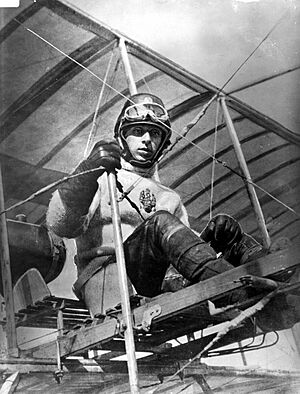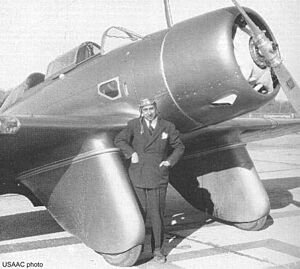Alexander de Seversky facts for kids
Quick facts for kids
Alexander de Seversky
|
|
|---|---|

Alexander de Seversky circa 1914
|
|
| Born |
Alexander Nikolaievich Prokofiev de Seversky
June 7, 1894 |
| Died | August 24, 1974 (aged 80) New York City, U.S.
|
| Resting place | Woodlawn Cemetery |
| Nationality | Russian American |
| Occupation | Aviator, author, inventor |
| Employer | Seversky Aircraft Corporation |
Alexander Nikolaievich Prokofiev de Seversky (born June 7, 1894 – died August 24, 1974) was a famous Russian-American aviation pioneer. He was an inventor and a strong supporter of using air power, like airplanes, to win wars by attacking important targets from the sky.
Early Life and Flying Dreams
Alexander de Seversky was born in Tiflis, which was then part of the Russian Empire (now Georgia). His family was noble, meaning they had a high social rank. When he was just 10 years old, he started attending a military school.
His father was one of the first people in Russia to own an airplane, and he taught young Alexander how to fly when he was only 14. After graduating with an engineering degree in 1914, Alexander joined the navy as Lieutenant Seversky, serving on a destroyer ship when World War I began.
A War Hero in the Sky
Alexander de Seversky was chosen to become a naval aviator, a pilot for the navy. He trained at the Military School of Aeronautics. In the summer of 1915, he joined an aviation unit in the Baltic Fleet.
On his very first mission, he attacked a German destroyer ship. However, his plane was shot down by enemy anti-aircraft fire before he could drop his bombs. The plane crashed, and the bombs exploded, sadly killing his observer and badly hurting Seversky. Doctors had to amputate his leg below the knee. Even though he got an artificial leg, the authorities said he couldn't fly in combat anymore.
But Seversky was determined. He showed up at an air show without permission and performed an amazing aerial display to prove he could still fly. He was arrested for this, but Tsar Nicholas II himself stepped in to help him.
In July 1916, Seversky was allowed to return to combat. Just three days later, he shot down his first enemy aircraft! He became a leading Russian naval ace, which means he was one of the top fighter pilots. He flew 57 combat missions and was credited with shooting down six German planes. For his bravery, he received many important awards.
Moving to the United States
During the Russian Revolution in 1917, Seversky was working in St. Petersburg. In March 1918, he was sent to the United States as part of the Russian Naval Aviation Mission. While in the U.S., he decided to stay there instead of returning to Russia, which was in chaos because of the Revolution. He settled in New York City.
Building an Aviation Career
In 1918, Seversky offered his skills as a pilot to the U.S. War Department. He became a consulting engineer and test pilot. After World War I ended, he worked with General Billy Mitchell, who was a strong supporter of air power. Seversky helped General Mitchell show that airplanes could sink battleships.
In 1921, Seversky received the first patent for air-to-air refueling, which is when one plane refuels another in the sky. Over the next few years, he made many other inventions, including an advanced bombsight that helped pilots aim bombs more accurately. In 1928, he became a major in the Army Air Corps Reserve.
Starting Seversky Aircraft Corporation
Using money from selling his bombsight invention to the U.S. government, Seversky started the Seversky Aero Corporation in 1923. This company focused on making aircraft parts. However, it struggled during the stock market crash of 1929.
In 1931, with help from investors, he restarted his company as the new Seversky Aircraft Corporation in Long Island, New York. Many of the designers at his company were Russian and Georgian engineers. They worked on advanced all-metal airplanes, like the SEV-3 amphibian, which could land on both land and water.
The SEV-3 was a groundbreaking design that set many speed records. Seversky often piloted these planes himself, showing off their capabilities. In 1935, he set a world speed record for piston-engine amphibious aircraft, flying over 230 miles per hour. He also set a record for flying across the country in 1938.
The SEV-3 led to a family of advanced aircraft, including the P-35A fighter plane. The Seversky Aircraft company worked on 25 different innovative projects.
In 1936, Seversky Aircraft moved into new facilities on Long Island. Even though they won several government contracts, the company didn't make a profit under Seversky's leadership. In 1939, while Seversky was away, the company's board of directors reorganized it and renamed it Republic Aviation Corporation. Seversky was eventually voted out of the company he had created. Republic Aviation went on to become a huge company, designing and producing famous planes like the Republic P-47 Thunderbolt during World War II.
Championing Air Power
As World War II approached, Seversky became very focused on his ideas about air warfare. After the Attack on Pearl Harbor, he wrote a book called Victory Through Air Power in 1942. In this book, he argued that using airplanes for strategic bombing (attacking important targets far away) was key to winning wars.
The book became a bestseller, selling five million copies. Its popularity led Walt Disney to turn it into an animated movie in 1943, where Seversky himself appeared to explain his ideas. Both the book and the film were very important during the war, helping people understand and discuss the power of air warfare.
Seversky was one of many people who believed in strategic air power. Their ideas led to the creation of the Strategic Air Command in 1946 and the development of large aircraft like the Convair B-36 and Boeing B-47 Stratojet. Seversky continued to share his ideas for new aircraft and weapons.
After the war, Seversky kept lecturing and writing about aviation and air power. He wrote more books, including Air Power: Key to Survival (1950) and America: Too Young to Die! (1961).
Personal Life
Alexander de Seversky married Evelyn Olliphant (1907–1967) in 1923. She was also a well-known pilot. They lived in New York City. In 1927, Seversky became a naturalized citizen of the United States. Evelyn passed away in 1967.
Seversky was often described as a "showman" because he was good at getting public attention and was considered a celebrity.
He was also a founder and trustee of the New York Institute of Technology. In 1972, a beautiful mansion was renamed "The DeSeversky Center" in his honor.
Alexander de Seversky passed away in 1974 in New York and was buried in the Woodlawn Cemetery.
Honors and Awards
Alexander de Seversky received many honors for his contributions to aviation:
- In 1939, he received the Harmon Trophy for his advancements in aviation.
- In 1945, President Harry Truman awarded him the Medal for Merit for his work on air power.
- In 1969, he received the Exceptional Service Medal for his service as a special consultant to the Chiefs of Staff of the U.S. Air Force.
- In 1970, Seversky was honored by being placed in the National Aviation Hall of Fame.
- In 1972, he received the Golden Plate Award from the American Academy of Achievement.
Books by Alexander P. de Seversky
- de Seversky, Alexander P. (1942) Victory Through Air Power, Simon & Schuster
- de Seversky, Alexander P. (1950) Air Power: Key to Survival, Simon & Schuster
- de Seversky, Alexander P. (1961) America: Too Young to Die!, McGraw-Hill
Seversky Aircraft Models
Before the company became Republic Aviation Corporation, Seversky Aircraft Corporation produced these planes:
- Seversky AT-12
- Seversky BT-8
- Seversky FN
- Seversky P-35
- Seversky XP-41
- Seversky 2PA
- Seversky A8V
- Seversky SEV-1XP
- Seversky SEV-3
- Seversky EP-106 (Export Pursuit)
- Seversky Navy Type S Two-Seat Fighter
See also
- Seversky P-35
- Republic Aviation
- Ionocraft


